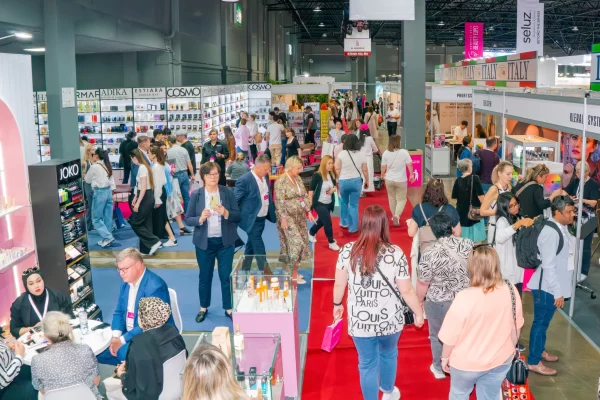The beauty industry in Central Asia is undergoing a major transformation. Central Asia Beauty Expo has emerged as the premier platform for international brands looking to tap into this dynamic market. We spoke with Saule Nursapayeva, the expo’s founder, to gain insight into the region’s beauty landscape and what international brands need to know when entering the market.
With increasing demand for high-quality beauty and haircare products, this event connects businesses with key players across Kazakhstan, Uzbekistan, Kyrgyzstan, Tajikistan, and beyond. What inspired you to start Central Asia Beauty Expo, and how did you establish it as a key event in the region?
I have been organising exhibitions for 18 years, first in Turkey and then in Kazakhstan, and from the start, I knew that success would come from a mix of international experience and local expertise. My partner Nursulu Kossuvalova and I combined our knowledge—she had deep connections within Kazakhstan, and I had experience working with global brands. This gave us an edge in attracting international exhibitors. At first, companies were sceptical about the market, and when we attended international trade shows, people didn’t even know how to pronounce Kazakhstan! But we worked hard to put Central Asia on the map, attending key beauty expos worldwide and promoting our event in international magazines.
What key factors have contributed to the event’s success?
A major part of our success is that we don’t just sell exhibitor space—we ensure exhibitors meet the right visitors. Many exhibitions focus only on collecting fees, but we actively curate visitors, invite serious buyers, host networking lounges, and offer personalised matchmaking services. This approach has built trust, and many exhibitors return every year. For 2024, we expect over 15,000 visitors from Central Asia, and the exhibition space is fully booked months in advance. The expo has now become the leading event in the region, and we are proud of what we have built.
How would you describe the current state of Central Asia’s beauty and haircare market?
The beauty market in Central Asia is growing rapidly. Economic development and rising disposable incomes mean consumers are more willing to spend on premium beauty products and salon services. Social media has also played a huge role in shaping consumer preferences—people follow global beauty trends closely and are more aware of product quality than ever before. The demand for professional salon services is increasing, with hair colouring especially popular. Women don’t like to colour their hair at home because they want professional results, and they trust high-quality European and Italian brands for this.
We also see a divide in purchasing behaviour: younger consumers often prefer cheaper Korean beauty products influenced by the K-pop trend. In comparison, older consumers (30+) prefer European brands, especially for skincare and haircare. Italian brands have a strong reputation because they deliver consistent results without damaging hair. French skincare brands are also very popular.
What are the biggest opportunities and challenges for international brands entering Central Asia?
There is huge potential for international brands in Central Asia as local production is still developing. While nail and fragrance manufacturing is strong, high-quality haircare and skincare require advanced formulations that local companies can’t yet match. This creates a strong demand for imported professional beauty products, especially from Europe. The key opportunity lies in building regional distribution networks and positioning as leaders in quality.
The biggest challenge is market adaptation. Many brands assume they can enter as they do elsewhere, but language barriers (Russian being dominant) and finding the right partners require careful preparation. Big distributors are selective, while smaller firms are eager to grow and can become valuable long-term partners. Brands that invest in market research, networking, and relationship-building are the ones that succeed.
How do you see local beauty brands evolving in Kazakhstan and neighbouring countries?
Local brands are growing, but competing with global players remains challenging. Nail care and perfume production are advancing, but skincare and haircare require significant investment in research, formulation, and quality ingredients. Many of them choose private-label production, allowing European haircare brands to remain dominant due to their trusted performance and safety.
As the market matures, innovation in local production is increasing. The younger generation is entrepreneurial, creating brands with unique selling points, and salon owners are becoming distributors. While Central Asia has the potential to develop strong regional beauty brands, international players still hold a major edge.
How are sustainability and innovation influencing the Central Asian beauty market?
Sustainability is slowly gaining traction, but it’s not yet a top priority for most consumers. However, the demand for eco-friendly and natural products is increasing, especially among higher-income consumers who prioritisze quality over price. Many people prefer European brands because they associate them with higher safety standards and ethical production.
At Central Asia Beauty Expo, we promote innovation by giving space to brands that bring something new to the market. We see increasing interest in organic haircare, skincare with clean ingredients, and professional beauty devices. The expo is a great platform for brands that want to showcase sustainable beauty solutions and educate the market on why quality matters.
What advice would you give international distributors and manufacturers attending the expo?
Preparation is everything. Brands must research the local market, trends, and competitors before attending the expo. They should bring materials in Russian because many buyers don’t speak English fluently. Having a local translator at the booth is essential to ensure smooth communication.Another key factor is offering samples—buyers in this region prefer to see, touch, and test products before making decisions. Unlike in larger European markets, there are not millions of distributors, so creating unique offers is important. The brands that succeed here invest time in building relationships and adapting to the local business culture.
How has your collaboration with Estetica Export helped expand the expo’s reach?
Our partnership with Estetica Export has been crucial in attracting Italian brands to Kazakhstan. Only a few Italian companies participated when we started, but today, we have 25 confirmed Italian exhibitors, and demand keeps growing. Estetica Export’s influence gives companies confidence in our event, and their support has significantly impacted our growth.
Because of this collaboration with Estetica Export and other magazines and organisations, the Italian Pavilion is now one of the highlights of our expo. Italian brands see real results, sign distribution deals, and spread the word. This year, again, we placed them at the very entrance of the expo, showing how much we value their presence. The partnership between Central Asia Beauty Expo and Estetica Export is strong, and we look forward to growing together in the future.






